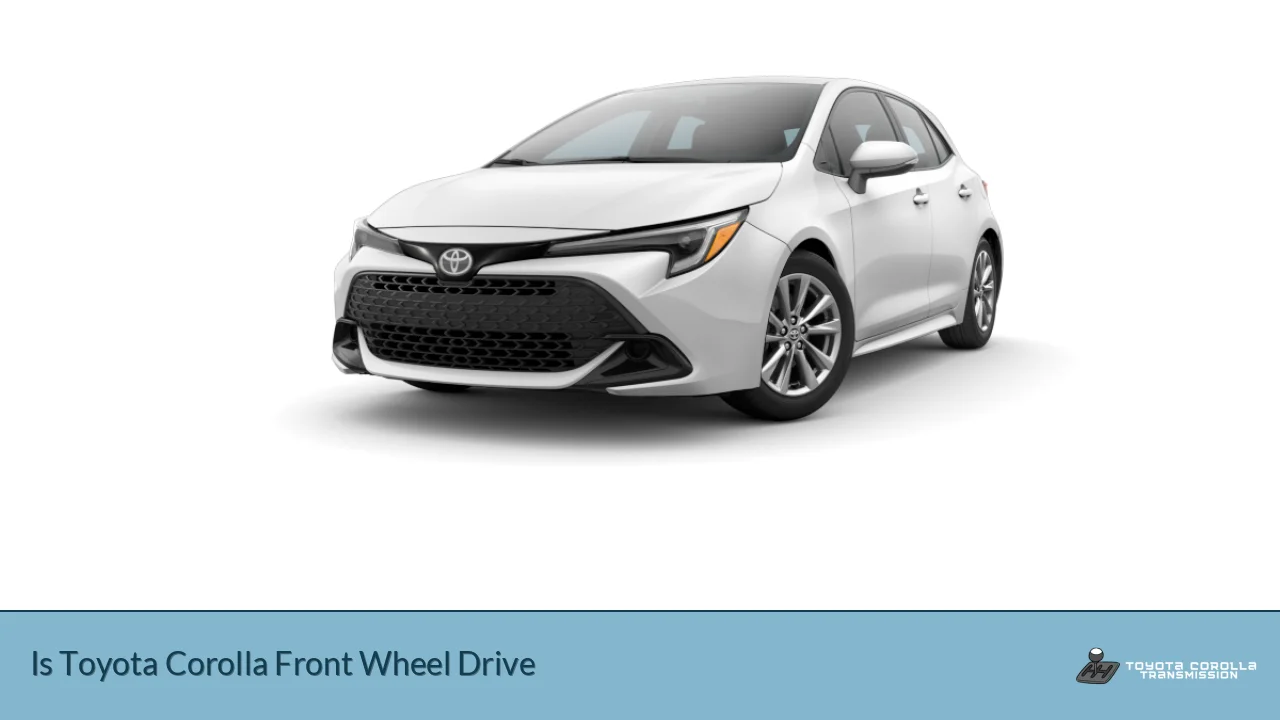The Toyota Corolla is predominantly known for its front-wheel drive (FWD) configuration. This design has been a hallmark of the Corolla since the late 1980s, transitioning from its earlier rear-wheel drive (RWD) models. The FWD layout provides several advantages, including better traction in adverse weather conditions and improved fuel efficiency due to fewer moving parts.
The current generation of the Toyota Corolla, which includes various body styles such as sedans and hatchbacks, continues to utilize the front-wheel drive system. This system directs power from the engine to the front wheels, allowing for a more compact design and enhanced handling characteristics. While some variants of the Corolla, particularly hybrids, may offer all-wheel drive (AWD), the standard models remain FWD.
| Drive Type | Details |
|---|---|
| Front-Wheel Drive | Standard in most Corolla models |
| All-Wheel Drive | Available in hybrid variants |
Overview of Front-Wheel Drive
Front-wheel drive is a drivetrain layout where the engine’s power is delivered to the front wheels. This configuration is common in many compact cars, including the Toyota Corolla. FWD vehicles are generally lighter than their RWD counterparts because they do not require a driveshaft to send power to the rear wheels.
The benefits of FWD include:
- Improved Traction: The weight of the engine over the front wheels enhances grip, especially in wet or snowy conditions.
- Better Fuel Efficiency: Fewer components mean less weight and improved fuel economy.
- More Interior Space: The absence of a rear driveshaft allows for more cabin space and a flatter floor.
In contrast, rear-wheel drive systems distribute power to the back wheels, which can offer better handling dynamics and performance in sports cars but often at the cost of increased weight and complexity.
Historical Context
The Toyota Corolla has evolved significantly since its inception in 1966. Initially, some models were designed with rear-wheel drive systems. However, starting with the E80 series in the 1980s, Toyota shifted towards front-wheel drive layouts for most of its Corolla lineup. This change aligned with industry trends favoring FWD for compact cars due to their advantages in efficiency and space utilization.
The last RWD Corollas were produced in the early 1980s. Since then, all mainstream models have utilized FWD configurations. This shift has allowed Toyota to maintain competitiveness in a rapidly changing automotive market.
Current Models and Variants
Today’s Toyota Corolla lineup includes various models that cater to different consumer needs. The standard sedan and hatchback versions are primarily FWD. However, there are hybrid versions that feature an all-wheel drive option.
Key Features of Current Models
- Engine Options: The Corolla typically offers several engine choices, including hybrid variants that combine electric motors with traditional gasoline engines.
- Transmission: Most Corollas come equipped with a continuously variable transmission (CVT), which optimizes fuel efficiency and provides smooth acceleration.
- Safety Features: Modern Corollas are equipped with advanced safety technologies as part of Toyota’s Safety Sense suite.
Performance Characteristics
The performance of a front-wheel drive vehicle like the Toyota Corolla is influenced by several factors:
- Handling: FWD vehicles tend to understeer when pushed hard into corners; however, they provide predictable handling characteristics that many drivers appreciate.
- Acceleration: FWD systems can struggle during hard acceleration due to weight transfer away from the front wheels; this can lead to wheel spin.
- Fuel Economy: The lightweight nature of FWD vehicles generally translates into better fuel economy compared to RWD vehicles.
Overall, while FWD may not deliver the same level of performance as RWD in high-performance scenarios, it offers sufficient capability for everyday driving needs.
Comparison with Other Drivetrain Layouts
When considering vehicle options, it’s essential to understand how front-wheel drive compares with other layouts like rear-wheel drive and all-wheel drive:
| Drivetrain Type | Advantages |
|---|---|
| Front-Wheel Drive | Better fuel economy, improved traction in rain/snow |
| Rear-Wheel Drive | Better handling dynamics, ideal for sports cars |
| All-Wheel Drive | Enhanced traction on slippery surfaces, improved stability |
Each drivetrain type has its unique benefits and drawbacks depending on driving conditions and personal preferences.
Consumer Considerations
When choosing between different drivetrain configurations, potential buyers should consider their driving habits and environmental conditions:
- Climate: For those living in areas with heavy snowfall or rain, FWD or AWD may be preferable for enhanced traction.
- Driving Style: Enthusiasts may prefer RWD for performance-oriented driving experiences.
- Fuel Economy Needs: If fuel efficiency is a priority, FWD vehicles like the Toyota Corolla are often more economical than their RWD counterparts.
The choice ultimately depends on individual preferences and requirements.
FAQs About Is Toyota Corolla Front Wheel Drive
- Is every Toyota Corolla model front-wheel drive?
Yes, all standard Toyota Corollas are front-wheel drive. - Can you get an all-wheel-drive version of the Toyota Corolla?
Yes, some hybrid variants offer an optional all-wheel-drive system. - What are the benefits of front-wheel drive?
FWD provides better traction in adverse weather and improved fuel efficiency. - Are there any disadvantages to front-wheel drive?
FWD can lead to understeering during aggressive cornering. - How does front-wheel drive compare to rear-wheel drive?
FWD is generally more fuel-efficient while RWD offers better handling dynamics.
In conclusion, the Toyota Corolla’s front-wheel drive configuration remains a significant factor contributing to its popularity among consumers seeking reliability and efficiency. With various options available across different models, buyers can select a vehicle that best fits their lifestyle while enjoying the benefits associated with this drivetrain layout.

